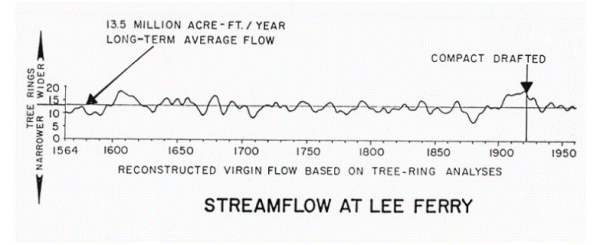The first reconstruction of streamflow for Lees Ferry (1976)
If some of the implications of Schulman's work failed to make an impression on water managers in the 1940s, it was probably because the demand for water in the Colorado River basin was much lower than it is today, and much lower than the flow of the river up until then. Over the next 30 years, though, a series of droughts lowered the observed long-term average natural flow, from 16 MAF (million acre-feet) per year in 1945 to 15 MAF/year in 1975, while water use in the upper and lower basins continued to rise. An engineering report for the Upper Colorado River Commission in 1965, titled "Water Supplies of the Colorado River", concluded that there was not enough water in the river to meet the full apportionments to both basins (16.5 MAF/year), and forecasted future water shortages. A U.S. Department of the Interior study in 1974 came to a similar conclusion.
Against this backdrop of increasing concern about the sufficiency of water supplies, a major effort was undertaken by Charles Stockton and Gordon Jacoby of the University of Arizona's Laboratory of Tree-Ring Research (LTRR) to use tree-ring data to reconstruct streamflows in the basin. The previous decade had seen major advancements in the number and quality of tree-ring datasets in the basin, and in the statistical and computing methods used to relate tree ring-width with streamflow and other variables. Much of this work was carried out under the direction of Harold Fritts of the LTRR.
Stockton (1975) had incorporated these new techniques into analysis and reconstructions for Colorado River and several tributaries, demonstrating the usefulness of dendrochronological methods for reconstructing records of past runoff in the southwestern U.S. Building on this work, Stockton and Jacoby (1976) developed a suite of annual runoff reconstructions for upper Colorado River gages with new tree-ring chronology collections and improved estimates of natural flow for calibration.
Stockton and Jacoby used 30 tree-ring chronologies from across the basin, 11 developed specifically for the study, to reconstruct annual streamflows at 12 different gages in the basin, including the Colorado River at Lees Ferry. Since much of the tree-ring data they used was collected in the mid-1960s, the calibration period extended only to 1961. They used principal components analysis (PCA) to extract main modes of variability from subsets of the 30 chronologies that best fit the variability in the gage-based streamflow records. For the final Lees Ferry streamflow reconstruction, Stockton and Jacoby used two different gage-based flow records (with different corrections for diversions and depletions) to calibrate three reconstruction models. They then calculated the average of the two reconstructions they believed were most reliable to create the final reconstruction.

The most striking result of Stockton and Jacoby's work was that the reconstructed long-term average flow at Lees Ferry, from 1564-1961, was only 13.5 MAF/year (the means of three models they developed ranged from 13.1 to 14.2 MAF/year). This was fully 10% lower than the 15.0 MAF/year average flow seen in the natural flow record up to 1975. This suggested that the 20th century was overall much wetter than the previous several centuries, and that the "dry" period from the 1930s to the 1960s was in fact "normal" and representative of long-term conditions. The Lees Ferry reconstruction also indicated that the period from 1905 to 1930 was the wettest such period in the past 400 years. In other words, the flows that were used as the basis of the Compact were anomalously high. Finally, the reconstruction showed several low-flow periods whose duration and/or magnitude were outside the experience of the gaged record, most notably the late 1500s. Over the 23-year period from 1573 to 1595, the reconstructed average annual flow was only 11.2 MAF.
The main message to Colorado River water managers from the Stockton and Jacoby tree-ring record was that water supplies in the basin were less adequate than one would presume from the much shorter natural flow record. This message, however, did not resonate for very long. After severe one-year droughts in 1977 and 1981, flows were above average from 1982 through 1987, including record high flows of about 25 MAF in both 1983 and 1984. In June 1983, the inflows to Lake Powell were so great that the outlet tunnels at Glen Canyon Dam were severely damaged. The problem of too much water eclipsed, if only temporarily, the threat of having too little.



